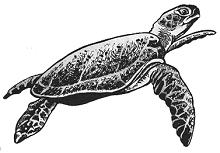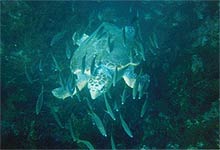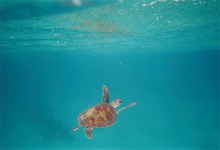
| |
|

|
I
live in the sea: Turtles the ancient
mariners of the sea
courtesy
Great Barrier Reef Marine Park Authority
|
| Marine
turtles are often called the ancient
mariners of the sea. They have been
swimming in the ocean for more than
150 million years, first appearing during
the age of the dinosaur. Turtles have
changed little since then, maintaining
an aquatic existence and only coming
ashore to lay eggs, producing another
generation to swim the seas.
One
of the highlights of a visit to the
Great Barrier Reef is spotting a marine
turtle. Of the seven species of marine
turtle, six are found in the waters
of the Great Barrier Reef Marine Park.
Green, hawksbill, and loggerhead turtles
are the most frequently sighted. Visitors
to the Marine Park have also spotted
flatback, leatherback, and olive ridley
turtles.
Although
a turtle's shell may make it look
ungainly or slow on land, the shell
is low-domed, streamlined and relatively
light, which allows a turtle to glide
easily through the water. The shell
also protects the turtle and helps
it float. Turtles swim with strong,
fin-shaped front flippers, which allow
the animal to move quickly through
the water, whilst its rear flippers
enable the turtle to steer and to
dig an egg chamber.
|

Interesting Fact
Sea turtles return to lay their eggs
in the
same region where they were born.
Drawing courtesy Wet
Paper |
| |
|

Cape Byron Marine Park is the feeding ground for
loggerhead (above) and green turtles (below).
Most will travel north to mate and lay eggs.

|
Turtles ingest large amounts of salt because they swallow seawater while foraging. Special glands beside the tear duct on the eye excrete the excess salt, giving the appearance of 'tears' when turtles are on land.
Between November and February, female turtles come out of the water to nest on land and lay several clutches of eggs. Once they've finished laying, the mums return to the ocean. Turtle hatchlings dig their way out of nests between January and April and head straight for the water as fast as they can. Many hatchlings do not survive their first day. Some are eaten by ghost crabs, feral pigs, and foxes before they even reach the water. Others are taken in the shallows by gulls, fish, sharks, and crocodiles. Only a small number of hatchlings get the chance to become adults - it is estimated that about 1 in 1000 hatchlings survive to adulthood.
Flatback turtles only nest on Australian beaches and are the most commonly seen turtle species nesting on mainland beaches in the Mackay Region.
Different species of turtles feed on different things. Green turtles eat primarily algae and seagrass; loggerhead and olive ridley turtles eat shellfish and crustaceans; hawksbills eat algae and sponges; and flatbacks eat sea pens, sea cucumbers and soft corals. Leatherback turtles feed almost exclusively on jellyfish.
|
|
|
Threats
At all stages of its
life, a marine turtle is vulnerable
to predators. Young and adult turtles
can be attacked by large cod, groupers,
sharks, crocodiles and killer whales.
Current
human pressures on turtle populations
in Great Barrier Reef waters include
bycatch in commercial fishing gear
(e.g. trawl nets), traditional hunting,
habitat degradation, boat strikes,
bycatch in shark control program gear,
and ingestion of or entanglement in
floating rubbish such as plastic bags
and fishing line which, if eaten,
can block a turtle's stomach. Lights
from coastal and island development
(particularly street lights) can confuse
new turtle hatchlings, causing them
to move inland from their nest, instead
of moving out to sea.
While
they are protected in their breeding
grounds of the Great Barrier Reef,
marine turtles face a number of threats
from human-related activities within
and adjacent to the Great Barrier
Reef Marine Park. Because turtles
are long-lived, slow growing, late
maturing animals, their population
can take many decades to recover.
Marine
turtles continue to play an important
part in the traditions and cultures
of Aboriginal and Torres Strait Islander
people living along the Great Barrier
Reef. Turtles (almost entirely green
turtles) are hunted in the Great Barrier
Reef World Heritage Area. The combined
marine turtle hunting mortality in
Australia and neighbouring countries
is thought to exceed the capacity
to replace losses, particularly for
the northern Great Barrier Reef green
turtle stock and hawksbill turtles.
|
|
|
What
you can do
Turtle
populations are declining throughout the
world. Here are some ways that you can help
save these animals:
- When
visiting beaches on the coast or islands
of the Great Barrier Reef, switch off
lights so that nesting turtles are not
disturbed and newly hatched turtles won't
be confused.
- When
visiting islands, keep pets at home. Dogs
and cats can destroy turtle nests and
kill hatchlings.
- Don't
throw any rubbish into the sea! Turtles
can become entangled in fishing gear and
mistake floating plastic bags for food.
- If
you're in a boat, make sure the driver
slows down in shallow water. Turtles and
other marine animals may be feeding.
- Do
not feed, touch or alarm a turtle, for
instance by loud noise or sudden movements.
Immediately report any sick, injured or
dead turtles to the Marine Wildlife Hotline
on 1300 360 898 (local call cost).
|
|
|
|
|
